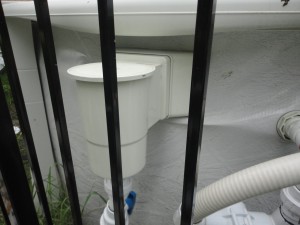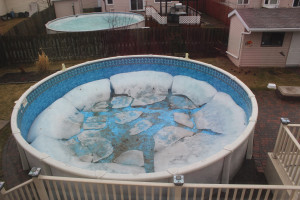Forward thinking
To be successful, a business must always be willing to test new technologies and/or procedures, which may have the potential to make their above-ground pool installations more durable, long lasting, and inexpensive. Two of the most important are liner guards and bonding.
Liner guards
The use of a geotextile liner guard—an extremely durable material that when used in association with soil has the ability to reinforce and protect—as part of an above-ground pool installation, eliminates pool liner damage caused by tree roots, ants and worms, as well as stones that can push through the sand base as a result of the freeze-thaw cycle. Prior to the availability of this technology, many installers used foam to protect pool liners; however, sometimes when dismantling these pools years later, installers discovered unevenness in the foam.
Not all clients understand the benefits of a liner guard and decide to have the pool installed without one; however, protecting the pool liner from the outside is important as it can save the client money by reducing the frequency of liner replacements. As an added benefit, a liner guard also creates a smoother pool floor, as opposed to using foam, which makes for easier vacuuming and pool cleaning.
Bonding the pool
For saltwater above-ground pool installations, incorporating a useful copper bonding (grounding) wire makes it much easier for the electrician to bond the salt system to metal components, such as the pool walls and skimmer screws. This procedure is in the pool owner’s best interest as not only does it help to prevent electrolysis from the salt chlorinator causing corrosion of metal parts, but it is also an important measure for bather safety.
Further, customers who purchase a salt chlorination system are required by most retailers to have their pools bonded by a certified electrician in order for the manufacturer to honour the warranty.
Do not forget about winterizing techniques
Just as it is important to be well-prepared for a successful installation, proper pool closing procedures in the fall are also vital to ensuring the client’s above-ground pool weathers the elements and stands the test of time.

There are a number of simple measures one can take to ready an above-ground pool for the long, frigid winter months that are experienced in areas such as the Outaouais region in western Quebec. Many in this region might think snow and ice are the biggest causes of above-ground pool damage and/or collapse; however, in reality, the number one reason is failing to winterize the pool properly.
In addition to water maintenance procedures (i.e. testing water parameters, shocking, and lowering the water level), along with removing any physical accessories (i.e. ladders, chemical feeders, skimmer basket, etc.), and draining water from equipment (i.e. pump, filter, and heater), attention to leaks, correct skimmer preparation, and the use of a winter cover are also strongly encouraged.
Leaky liners
Prior to winterizing the pool, companies should emphasize with their customers the importance of keeping a watchful eye for any leaks before the winter freeze.

If a leak is found, the pool owner should call their installer/local pool company immediately. If an above-ground pool loses water throughout the winter, the ice ‘cake,’ which forms at the water surface can drop and damage the liner and pool structure. This is another major reason why above-ground pools are damaged in the Ottawa-Outaouais region.
Skimmer closing
It is extremely important that a foam kit, plug and/or faceplate cover is used to ready the skimmer for the winter. These accessories, which fit into or attach to the face of the skimmer, prevent ice from bridging and causing severe damage to the pool. By not using one of these kits water will eventually enter the skimmer and freeze, connecting (bridging) the skimmer with the surface layer of ice, which forms in the pool. Ice bridging can damage both the skimmer and metal wall as the layer of ice in the pool will often rise and shift with snow, ice, and rain throughout the winter season.
The winter cover
The winter cover is the final step in the winterizing regimen. These covers are typically made of laminated polyethylene and come in various strengths. Most covers on the market today only provide a 1- to 1.2-m (3- to 4-ft) overlap; however, a 1.8-m (6-ft) overlap is recommended. The additional overlap allows the cover to float on the water loosely rather than being tight around the pool frame, which causes unwanted strain on the pool structure.
 Brian Babb is the pool service manager for Mermaid Pools and Hot Tubs, which has locations in Gloucester and Nepean, Ont., as well as Gatineau, Que. Babb has been in the pool service industry for 15 years. He can be reached via e-mail at poolservice@mermaidpools.com.
Brian Babb is the pool service manager for Mermaid Pools and Hot Tubs, which has locations in Gloucester and Nepean, Ont., as well as Gatineau, Que. Babb has been in the pool service industry for 15 years. He can be reached via e-mail at poolservice@mermaidpools.com.
 Myrtle Myers oversees the above-ground department for Mermaid Pools and is the purchaser for pool related products. She has worked in the pool business for more than 20 years. She can be reached via e-mail at mmyers@mermaidpools.com.
Myrtle Myers oversees the above-ground department for Mermaid Pools and is the purchaser for pool related products. She has worked in the pool business for more than 20 years. She can be reached via e-mail at mmyers@mermaidpools.com.







I am interested to buy an on ground pool (smallest size) kidney or key shape…60 inch flat bottom for a new construction.
Please send me your best price for pool and installation…no accessories such a heatpump or salt system…basic need for a tight budget.
Thanks.